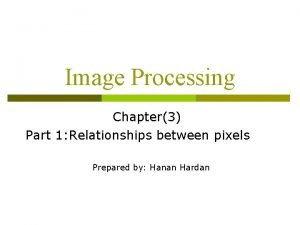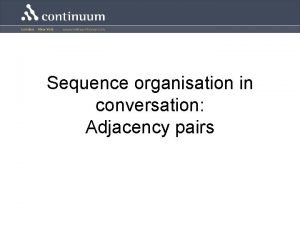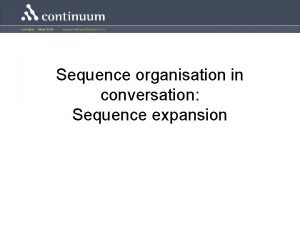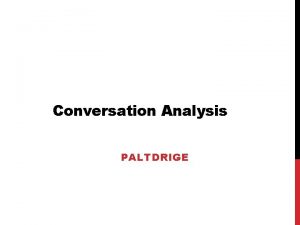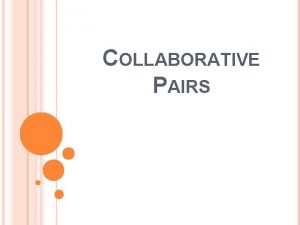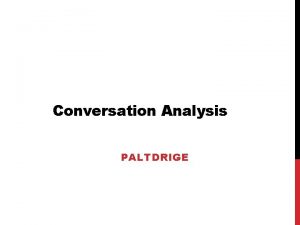Sequence organisation in conversation Adjacency pairs Sequence organization









- Slides: 9

Sequence organisation in conversation: Adjacency pairs

Sequence organization • Turns at talk are organized to be coherent and orderly and the relationship between turns is a meaningful one. • This clustering of turns at talk is referred to as sequence organization. • Turns at talk cluster together in order for speakers to develop a course of action.

Adjacency pairs • In conversation turns at talk occur as pairs: adjacency pairs – Adjacency pairs are the basic unit on which sequences in conversation are built. – Adjacency pairs have a number of core features: (1) They consist of two turns (2) by different speakers, (3) which are placed next to each in their basic minimal form, (4) which are ordered and, (5) which are differentiated into pair types.

Adjacency pairs • The two turns in an adjacency pair are ordered: – First pair parts initiate conversational actions – Second pair parts flow from the action and work to complete • The relationship between FPPs and SPPs is constrained by the type of FPP produced: the SPP must be of the appropriate type for the action initiated by the FPP. it.

Adjacency pairs The basic sequence is composed of two ordered turns at talk: A: first pair part B: second pair part

Adjacency pairs and turn-taking • The basic two-turn sequence is closely linked to the turntaking system because it makes speaker change a relevant next action. • Producing an adjacency pair requires that – once a recognisable FPP has been produced, – on the first possible completion, – the current speaker should stop and – a next speaker should start and produce an SPP of the relevant type.

Relevance rules • FPPs create a context in which – some next action is expected to occur and – the talk that is produced after it will be seen as in some way responding in a relevant way to the FPP. – If there is no next talk, this will be seen as missing.

Types of second pair parts • A small number of adjacency pair types have only a single type of SPP. – greeting adjacency pairs (hello, hi, etc. ) – terminal adjacency pairs (bye, goodbye, seeya, etc. ) • Most adjacency pair types have alternative possibilities for realising the SPP.

Types of second pair parts

